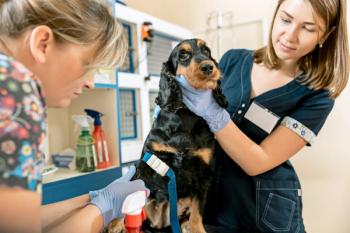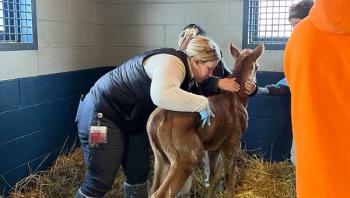
Industry, profession questions AAHA vaccine guidelines; minor changes made while confusion grows
Cleveland-Just months after the release of the new canine vaccine guidelines, the American Animal Hospital Association (AAHA) has agreed to make two minor revisions and continues to stand behind its recommendations despite some criticism from practitioners and industry.
Editor's Note: Due to a magazine production and printing error, lastmonth's cover story is being reprinted in its entirety. The story is alsoavailable on www.dvmnewsmagazine.com. We regret the inconvenience.
Cleveland-Just months after the release of the new canine vaccine guidelines, the American Animal Hospital Association (AAHA) has agreed to make two minor revisions and continues to stand behind its recommendations despite some criticism from practitioners and industry.
At the center of the criticism is why AAHA used unpublished studies todevelop the guidelines and why the entire report is not being made readilyavailable to veterinarians.
Dr. John Albers, AAHA executive director, says he has been contactedby some manufacturers regarding the guidelines and has agreed to make "minor"changes.
"We actually have been very pleased that there hasn't been any significantfallout or uproar over this," Albers says. "Our feedback thatwe have gotten is that (the guidelines) have been very well received."
AAHA has agreed to remove two editorial comments from Table 1 of thedocument regarding Bordetella bronchiseptica and Borrelia burgdorferi, Alberssays.
However, industry leaders claim there are still questions pertainingto the document, and it has created confusion among practitioners on implementingthe guidelines. Critics charge that AAHA is not doing enough to supportits recommendations.
"Veterinarians are confused about what these guidelines mean, andwhat they represent," says Craig Wallace, director of companion animalbusiness for Fort Dodge Animal Health. "I think there is a lot morethat needs to be done before veterinarians understand what the intent ofthese were, and I don't think the guidelines were clearly communicated."
Dr. Janine Pepin, owner of Tender Loving Care Animal Hospital in Medina,Ohio, already felt some uncertainty about the new guidelines and is nowwaiting to see what the modifications are before she adopts the protocolsin her own practice.
"I definitely have more questions than answers right now and tohear there might be some changes to the new guidelines will make me waita little longer," she says. "I need to feel I can trust theserecommendations before I implement them because the transition can be bumpywith clients."
As a general practitioner, Pepin says she walks a fine line with herclients when recommending changes in the health care of their pets.
"It's difficult to implement changes in your recommendations, especiallywhen it comes to new drugs and vaccines," she says. "You can'tconstantly keep making changes and expect your clients to accept them. Itcan undermine their confidence in you."
Under review
As manufacturers started digging into the specific recommendations, somecompany leaders believe they have uncovered some problems with the document.
Biocor and Fort Dodge approached AAHA officials about proposed changesto Table 1 of the document, because they felt some information was incorrect,Albers says.
Specifically, Fort Dodge officials were concerned about the referencemade in the section pertaining to Borrelia burgdorferi vaccination thatstates:
"Most authoritative papers recommend the rLyme borreliosis vaccineover the killed bacterin for reasons of safety (believed to be associatedwith fewer adverse reactions)."
Fort Dodge officials say the information was incorrect and contactedAAHA.
Albers says those editorial comments were made during the developmentprocess. When it was brought to the attention of AAHA leaders, they decidedit should be removed.
Similar revisions were made in the same table regarding Bordetella bronchiseptica.The changes helped clear up inconsistencies between the executive summaryand the tables that accompany the document, Albers says.
"The changes made are not like we are now recommending annual vaccinationsinstead of every three years," he says. "It wasn't a huge changelike that."
Adam Yankowsky, director of sales and marketing for Biocor Animal Health,says Biocor contacted AAHA because it felt some of the comments made aboutthe vaccines for Bordetella bronchiseptica were based more on opinion thanfact.
"We wanted to make sure AAHA's recommendations were based on themost recent science as possible," he says.
Biocor scientists were able to provide AAHA with additional scientificdata that led to the correction, Yankowsky says.
Zack Mills, DVM, executive director of veterinary professional servicesfor Merial Ltd., agrees that some editing changes need to be made to theguidelines.
"I just think there was some poor choice of words in parts of thedocument that could have been edited if manufacturers could have reviewedthe guidelines beforehand and made their recommendations," he says."It's not to say they had to accept all of them but at least we couldhave made our comments known."
Missing link?
Leaders from both Fort Dodge and Merial agree that some changes couldhave been avoided if industry was allowed to play more of a role in developingthe guidelines.
Mills commends AAHA's effort to address a very controversial issue anddevelop recommendations based on the available data.
"It's a good first attempt, and it has opened discussions on theissue," he says. "But, it also makes it easy for everyone to armchairquarterback now that the document has been released."
"We did not try to have every single company represented at thetable," Albers says.
A member of the Animal Health Institute did provide some advice but didnot serve as an industry representative, Albers adds.
During The North American Veterinary Conference in January, AAHA hostedan informational meeting for all the canine vaccine manufacturers to updatethem on the new guideline recommendations.
"As a result of that, some of them did write and make comments,"Albers says.
Some changes came before the guidelines were published while others currentlyare being considered, Albers says.
"A lot of the companies didn't have any input at all," he says."Many were more interested in how we were going to distribute the informationand when it was going to be released so their sales forces could be preparedfor it. They were very appreciative of the opportunity to get a heads-up."
But that might not have been enough for companies that plan to bringother issues to the forefront.
Although AAHA provided vaccine manufacturers with a preview of the newguidelines, some industry officials hoped they could have been more involvedin the process, Yankowsky says.
"I don't expect them to run everything by us. They have to do whatthey want to do, but when it affects manufacturing we hopefully would havesome input because we're also held to the guidelines of the USDA,"he says.
Fort Dodge is currently gathering information to present to the taskforce regarding the guidelines, Wallace says.
Although Albers says AAHA has an open door policy and will listen toany comments or concerns from industry officials or from the profession,it's unlikely any more revisions will be made to the guidelines at thistime.
Dr. Michael Paul, chairman of the AAHA canine vaccine task force, echoedthose comments by saying that industry had time to make its comments andthe purpose of the document was to give practitioners guidelines that werenot heavily influenced by industry.
"This was not intended to be an industry document," Paul says."It was intended to be a guideline for practitioners."
Mills expects some changes will be made to the AAHA canine vaccine guidelinesbecause he considers the report a working document.
"These guidelines are fluid and hopefully will continue to havechanges," he says. "(AAHA) and veterinarians have to expect thesechanges, and they should be willing to discuss them."
As new vaccines enter the market, the guidelines will have to be alteredto reflect new technology and how the profession will effectively incorporatethem into practice, Mills says.
"I think the message we're trying to convey to industry is if youhave information that we are not aware of please send it to us," Alberssays. "We're not saying we believe this document is the final word."
Pfizer Animal Health was unaware of changes being made to the guidelinesand declined comment. At press time, Intervet and Schering Plough AnimalHealth had not returned telephone calls seeking comment.
Access to the facts
But perhaps the biggest question raising eyebrows from veterinariansand some industry leaders is why the AAHA task force used unpublished datafrom Ronald Schultz, Ph.D., dipl. ACVIM and a task force member, to developthe guidelines.
Since 1978, Schultz, a professor at the University of Wisconsin Schoolof Veterinary Medicine, has conducted a variety of studies directly relatedto the efficacy and duration of immunity of vaccines. Some of his work includesexperimental control studies where 19 dogs of various breeds were vaccinatedonce for parvovirus, adenovirus and distemper and then were challenged withthe viruses beginning at seven years following inoculation. Some dogs inthat study were challenged as far out as 11 years after vaccination.
"The reason we picked seven is because we didn't have very manyanimals at eight, nine or 11 (years). Although the protection was very goodthere, the majority of animals were in the seven-year range," he says.
Another study Schultz conducted examined the duration of immunity for82 Beagles ranging in age from 13 months to 10 years of age and challengedwith the viruses again at different year intervals.
Five years ago the veterinary teaching hospital at the University ofWisconsin moved to a three-year protocol for administering core vaccines.Since the transition, Schultz has been tracking more than 500 canine patientsat the veterinary teaching hospital by collecting their blood for serumtesting when they come in for annual wellness exams. This allows Schultzto track dogs at different yearly intervals post vaccination to measurethe duration of immunity of the vaccines.
"We also have owners who have decided they don't even want to vaccinateat three years," Schultz says, which goes against the teaching hospital'srecommendations.
Despite this in-depth research, Schultz has never published detailedreports on his studies. However, he has released brief summaries on someof the studies, but they are not widely known in the veterinary profession.Schultz says he hopes to publish complete reports on his studies some timethis summer.
Pepin thinks it's critical for Schultz's information to be published.
"We need to be able to read the opinions of all the scientists andexperts in immunology and see all the data to fully understand their opinionsbefore we make our own decisions," she says. "Otherwise we'renot going to have the confidence to institute the guidelines or developour own. Even though AAHA is there and is an excellent credible source toguide us, we're still going to want to have access to all that information."
Why three-year intervals?
Some veterinarians also question why the task force chose three yearsas the benchmark for administering vaccines.
"That's another embarrassing question. It's completely arbitrary.It's just completely arbitrary," says Richard Ford, DVM, MS, dipl.ACVIM and member of the AAHA Canine Vaccine Task Force. "I will saythere is no science behind the three-year recommendation, and that's completelytrue with the cat."
Ford says the decision to recommend a three-year cycle for vaccines wasa compromise.
"We picked a compatible medium, and it corroborates and correspondswith what was recommended for the cat too," he says. "We havesome level of consistency, but there's nothing magical about three yearsat all.
"There are not a lot of studies to support the three-year durationof immunity that are clinically-controlled, challenge studies which aredone under good laboratory conditions," Ford says.
Conducting such studies is very difficult to accomplish because of thetime and cost that must go into them, he says. To perform a challenge study,the dogs are put in very isolated conditions for several years and are exposedto a variety of viruses.
Schultz agrees with Ford adding that he picked the three-year intervalbecause he thought practitioners would be more likely to accept it.
"I thought if the veterinarian understood that if a killed rabiesvaccine could work for three years that they could surely understand thata modified-live distemper, adeno or parvo (vaccine) could work for threeyears, minimum," he says. "Modified-live vaccines have a muchlonger duration of immunity than killed vaccines."
However, Schultz admits some vaccines still need to be administered annuallyto dogs if there is truly a risk of the animal getting the disease. He useskennel cough and the leptospira vaccines as examples. He says dogs thatlive in endemic areas for these diseases may need to receive vaccines onan annual basis or perhaps even more frequently in the case of leptospira.However, he advises practitioners to consider all the pros and cons beforemaking their decisions.
AAHA has published two documents pertaining to the 2003 AAHA Canine VaccineGuidelines and Recommendations. An executive summary was published in theMarch/April issue of the Journal of the American Animal Hospital Associationand the April/May issue of Trends magazine. AAHA's Web site (www.aahanet.org)provides a complete report of the guidelines, but it is only available toAAHA members. The complete report includes additional sections pertainingto immunology, duration of immunity, serological testing, vaccine production,adverse-event reporting and legal implications of biological use. The fullreport also addresses how vaccinations serve as a component of comprehensiveindividualized care.
Restricting this material only to AAHA members makes it difficult forpractitioners to develop their own opinions and protocols because they areunable to review the data.
"I would think that practicing veterinarians would want to lookat all the information that is available and then decide what is most appropriatefor their practice, for the pets in their practice and the environment thosepets are in," Wallace says.
"We're proponents of laying all the information out there and havingveterinarians make the decisions based on most current information,"he says.
Pepin says she is reluctant to make changes until she reviews all thematerial.
"I find this very frustrating because I don't think I should haveto be an AAHA member to have access to even part of that data let alonethe full report," Pepin says. "That's where the ambiguity lies.I want to do the right thing. The time has come, and I realize there aregoing to be economic issues because of these changes, but there has to besupport to make that transition."
AAHA currently is working with the American Veterinary Medical Associationto also make the entire report available to its members, Albers says.
Lack of education
Ford along with some industry officials say they talk daily with practitionerswho are still trying to decipher the new guidelines and how to implementthem.
"The bottom line here is what are we going to do with these guidelines?Why were these guidelines written, and how do I use them?" Ford says."These are the questions I keep hearing veterinarians ask."
During the last few months, Ford has been traveling the country speakingon the topic of vaccines for Merial and he says he keeps hearing this centraltheme from practitioners.
"They are consistently skeptical of using (the guidelines) becausethey don't know how," he says. "There is no definition on howto implement the guidelines, so we're stuck with that, and I think it hasbeen confusing for practitioners."
Ford is in the process of developing a Web site on vaccines and plansto include examples of how to implement vaccine protocols from birth tolife using rotating schedules. The Web site should be up and running sometimethis summer.
"What we have done very well in our profession is to educate clientsthat vaccines are to be given every year. The need for shots is what bringspeople into the veterinarian at the very beginning," Ford says. "Sogiven that, nobody on either the cat or the dog task forces has recommendedwe do anything but annual vaccinations. Nobody is saying just vaccinateevery three years. Just don't vaccinate for everything every year."
Ford says practitioners can develop a rotating schedule that allows themto incorporate vaccines annually.
Mills says AAHA has a responsibility to educate both veterinarians andthe public on the new guidelines.
"We're spending a lot to educate the veterinarian, not to have Merialmake more money on vaccines," he says. "I think that's where AAHAmissed the boat."
Mills also would like to see AAHA develop a public education campaignthat explains why the new guidelines were developed and how it impacts dogsand their owners.
"They need to help get rid of the idea that vets are just vaccinatingfor money," Mills says. "That's not the reason why they are vaccinating.(Vaccines) work very, very well in controlling disease and to keep petshealthy and happy."
AAHA has no specific plans to offer veterinarians any resources to implementthe guidelines or to address the public's questions, Albers says.
Paul says the new guidelines should not come as a big surprise to theveterinary profession because the topic has been talked about for years.
"AAHA has been publishing and giving presentations for the lastfour or five years to let people know these changes were coming and to getprepared for them," he says. "Unfortunately, too many people inthe profession did not want to hear what we were telling them and didn'trealize the impact the (changes) would have. They were looking at it butnot wanting to hear it."
AAHA reiterates that the guidelines were designed to help practitionersdevelop their own protocols and that this area of medicine will continueto evolve.
"There's new knowledge all the time so there's nothing cast in stone,"Albers says.
Newsletter
From exam room tips to practice management insights, get trusted veterinary news delivered straight to your inbox—subscribe to dvm360.




